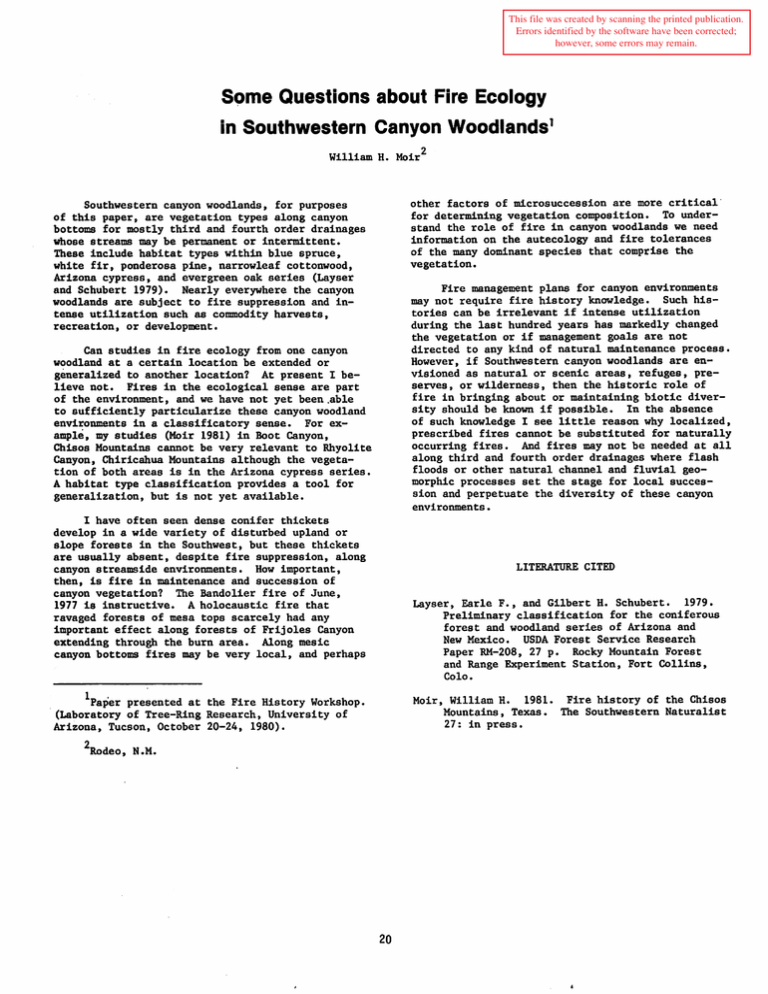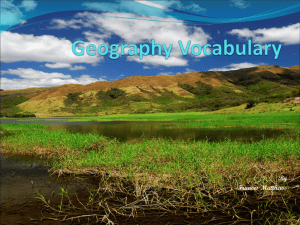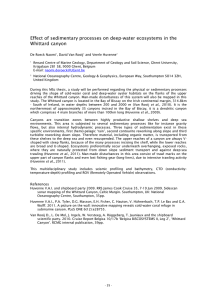S9me Questions about Fire Ecology In
advertisement

This file was created by scanning the printed publication. Errors identified by the software have been corrected; however, some errors may remain. S9me Questions about Fire Ecology In Southwestern Canyon Woodlands 1 William H. Moir other factors of microsuccession are more critical· for determining vegetation composition. To understand the role of fire in canyon woodlands we need information on the autecology and fire tolerances of the many dominant species that comprise the vegetation. Southwestern canyon woodlands, for purposes of this paper, are vegetation types along canyon bottoms for mostly third and fourth order drainages whose streams may be permanent or intermittent. These include habitat types within blue spruce, white fir, ponderosa pine, narrowleaf cottonwood, Arizona cypress, and evergreen oak series (Layser and Schubert 1979). Nearly everywhere the canyon woodlands are subject to fire suppression and intense utilization such as commodity harvests, recreation, or development. Fire management plans for canyon environments may not require fire history knowledge. Such histories can be irrelevant if intense utilization during the last hundred years has markedly changed the vegetation or if management goals are not directed to any kind of natural maintenance process. However, if Southwestern canyon woodlands are envisioned as natural or scenic areas, refuges, preserves, or wilderness, then the historic role of fire in bringing about or maintaining biotic diversity should be known if possible. In the absence of such knowledge I see little reason why localized, prescribed fires cannot be substituted for naturally occurring fires. And fires may not be needed at all along third and fourth order drainages where flash floods or other natural channel and fluvial geomorphic processes set the stage for local succession and perpetuate the diversity of these canyon environments. Can studies in fire ecology from one canyon woodland at a certain location be extended or generalized to another location? At present I believe not. Fires in the ecological sense are part of the environment, and we have not yet been.able to sufficiently particularize these canyon woodland envi~onments in a classificatory sense. For example, my studies (Moir 1981) in Boot Canyon, Chisos Mountains cannot be very relevant to Rhyolite Canyon, Chiricahua Mountains although the vegetation of both areas is in the Arizona cypress series. A habitat type classification provides a tool for generalization, but is not yet available. I have often seen dense conifer thickets develop in a wide variety of disturbed upland or slope forests in the Southwest, but these thickets are usually absent, despite fire suppression, along canyon streamside environments. How important, then, is fire in maintenance and succession of canyon vegetation? The Bandolier fire of June, 1977 is instructive. A holocaustic fire that ravaged forests of mesa tops scarcely had any important effect along forests of Frijoles Canyon extending through the burn area. Along mesic canyon bottoms fires may be very local, and perhaps . 2 LITERATURE CITED Layser, Earle F., and Gilbert H. Schubert. 1979. Preliminary classification for the coniferous forest and woodland series of Arizona and New Mexico. USDA Forest Service Research Paper RM-208, 27 p. Rocky Mountain Forest and Range Experiment Station, Fort Collins, Colo. 1Paper ' presented at the Fire History Workshop. (Laboratory of Tree-Ring Research, University of Arizona, Tucson, October 20-24, 1980). Moir, William H. 1981. Fire history of the Chisos Mountains, Texas. The Southwestern Naturalist 27: in press. 2 Rodeo, N.M. 20






